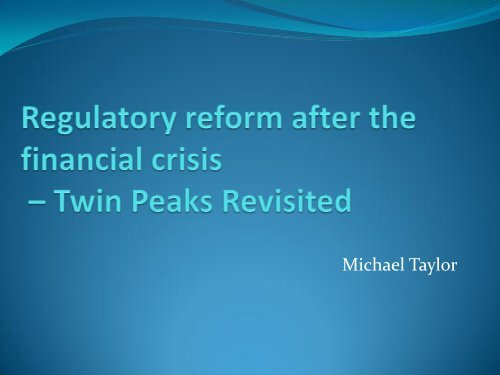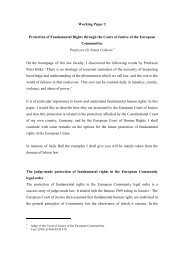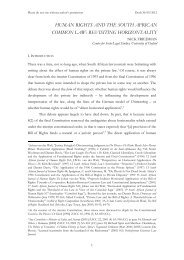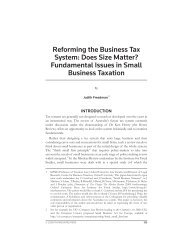Twin Peaks Revisited - Centre for Competition Law and Policy
Twin Peaks Revisited - Centre for Competition Law and Policy
Twin Peaks Revisited - Centre for Competition Law and Policy
Create successful ePaper yourself
Turn your PDF publications into a flip-book with our unique Google optimized e-Paper software.
Michael Taylor
Outline<br />
� Does the structure of regulatory agencies matter?<br />
� The “<strong>Twin</strong> <strong>Peaks</strong>” analysis<br />
� Functional despecialisation <strong>and</strong> financial conglomerates<br />
� From analysis to structure<br />
� <strong>Twin</strong> <strong>Peaks</strong> in practice<br />
� Why did the UK choose a single regulator?<br />
� Lessons of the crisis<br />
� UK re<strong>for</strong>ms
Does regulatory structure<br />
matter?<br />
� Sometimes dismissed as “rearranging the deckchairs<br />
on the Titanic” (Martin Wolf)<br />
� Temptation <strong>for</strong> politicians to change regulatory<br />
structures after a crisis to be seen “to do something”.<br />
� Other factors influencing effective supervision:<br />
� Clear objectives<br />
� Independence <strong>and</strong> accountability<br />
� Adequacy of resources<br />
� Effective en<strong>for</strong>cement powers<br />
� Comprehensiveness of regulation (Abrams/Taylor 2000)
But structure not irrelevant<br />
� Comprehensiveness<br />
� Ensuring no significant market or intermediary escapes<br />
effective supervision<br />
� Cost efficiency<br />
� Avoid duplication of resources/activities<br />
� Coordination<br />
� Ensure that all aspects of a firm’s operations are<br />
adequately supervised<br />
� Especially important in crisis management
The traditional structure<br />
� Institutional supervision or combination of<br />
institutional <strong>and</strong> functional<br />
� Institutional – <strong>for</strong> prudential soundness, e.g. separate<br />
regulations <strong>for</strong> banks, insurers, securities firms<br />
� Functional – by product type – <strong>for</strong> consumer<br />
protection purposes<br />
� E.g. UK system prior to 1997<br />
� Banking Act 1987<br />
� Financial Services Act 1986<br />
� Insurance Companies Act 1982
Justification <strong>for</strong> traditional<br />
approach<br />
� Clear separation/segmentation of financial sector<br />
along industry lines<br />
� In some cases segmentation due to legislative decree<br />
(e.g. Banking Act 1933 in US), in others due to custom<br />
<strong>and</strong> practice (UK pre-Big Bang).<br />
� Banks the only systemically important financial<br />
institutions: required special level of supervision <strong>and</strong><br />
regulation <strong>and</strong> oversight usually provided by central<br />
bank (as lender of last resort)
Traditional approach outmoded<br />
� Changes in industry structure<br />
� Changes in nature of products<br />
� Neither institutional nor functional approaches were<br />
adequate
Changing industry structure<br />
� Financial conglomerates<br />
� Abolition of <strong>for</strong>mal (Glass-Steagall) <strong>and</strong> in<strong>for</strong>mal<br />
(U.K.) restrictions on investment/commercial banking<br />
combinations<br />
� Bank-insurance linkages becoming commonplace<br />
� How to obtain a “group-wide” perspective to monitor<br />
their prudential soundness? (Tripartite Group,<br />
Supervision of Financial Conglomerates, 1995)
Changing nature of products<br />
� New financial products that overlapped conventional<br />
deposit/insurance/securities boundaries<br />
� E.g. Credit Default Swaps – credit or insurance?<br />
� Especially problematic <strong>for</strong> consumer protection – who<br />
regulates which product?<br />
� But also a systemic dimension – OTC (over-thecounter)<br />
derivatives markets increased the<br />
interconnectedness of institutions, banks <strong>and</strong> nonbanks
<strong>Twin</strong> <strong>Peaks</strong> analysis vindicated<br />
� The crisis has shown that:<br />
� Industry concentration – in the <strong>for</strong>m of financial<br />
conglomerates or “Large Complex Financial<br />
Institutions” – now an established part of the financial<br />
l<strong>and</strong>scape<br />
� A wide range of firms (not just banks) are potentially<br />
systemically important institutions (Lehman, AIG)<br />
� To this extent <strong>Twin</strong> <strong>Peaks</strong> analysis has been justified:<br />
the chain of collapse ran through non-banks, “too<br />
interconnected to fail”
The <strong>Twin</strong> <strong>Peaks</strong> alternative<br />
� Taylor (1995); Goodhart (1995); Australian Financial<br />
System Inquiry (1996)<br />
� Structure regulation according to objective or purpose<br />
� Two regulatory agencies<br />
� Financial stability = ensure the prudential soundness<br />
of financial institutions irrespective of legal <strong>for</strong>m<br />
� Consumer protection = ensure adequate<br />
disclosure/consumer protection <strong>for</strong> all products<br />
irrespective of legal <strong>for</strong>m<br />
� What role <strong>for</strong> the central bank?
<strong>Twin</strong> <strong>Peaks</strong> in Practice<br />
� <strong>Twin</strong> <strong>Peaks</strong> model adopted first in Australia following<br />
the Financial System Inquiry (“Wallis Commission”)<br />
which reported in 1996<br />
� Established two agencies – APRA <strong>and</strong> ASIC<br />
� Banking supervision function removed from RBA.<br />
� Netherl<strong>and</strong>s followed in 2002.<br />
� Dutch <strong>Twin</strong> <strong>Peaks</strong> model kept central bank (DNB) as<br />
prudential regulator <strong>for</strong> banks, insurers & pension<br />
funds<br />
� New consumer protection regulator - AFM
UK single regulator<br />
� Soon after May 1997 General Election the new Labour<br />
government announced creation of a single regulator<br />
(FSA) combining functions of nine previously existing<br />
regulators.<br />
� Justification <strong>for</strong> the FSA drew heavily on the <strong>Twin</strong><br />
<strong>Peaks</strong> analysis<br />
� But <strong>Twin</strong> <strong>Peaks</strong> was rejected in the UK in favour of a<br />
single integrated regulator<br />
� Financial Services <strong>and</strong> Markets Act 2000<br />
� FSA came into being be<strong>for</strong>e legislative enactment
Why was the FSA established?<br />
� Justification provided by Brown (as Chancellor)<br />
echoed <strong>Twin</strong> <strong>Peaks</strong> – “blurring of boundaries”<br />
� But <strong>Twin</strong> <strong>Peaks</strong> rejected because prudential <strong>and</strong><br />
consumer protection regulation had strong synergies –<br />
involved many of the same issues (e.g. management,<br />
systems <strong>and</strong> controls) (Briault, 1998)<br />
� Real reasons were more political:<br />
� Labour distrust of Bank of Engl<strong>and</strong><br />
� Parliamentary timetable
UK’s system pre-crisis<br />
� Clear separation of roles between BoE <strong>and</strong> FSA.<br />
� BoE focused on monetary policy.<br />
� FSA focused on micro-prudential supervision <strong>and</strong><br />
(especially) consumer protection.<br />
� Who was responsible <strong>for</strong> financial stability?<br />
� Who was responsible <strong>for</strong> crisis management?<br />
� Tripartite arrangements (Treasury, BoE, FSA) were<br />
unwieldy <strong>and</strong> wilted in heat of crisis. No one in overall<br />
charge.
Lessons <strong>for</strong> regulatory structure<br />
� <strong>Twin</strong> <strong>Peaks</strong> superior to a single regulator because it<br />
permits each agency to focus on a single objective:<br />
� Political priority likely to be given to consumer<br />
protection versus prudential regulation (House of<br />
Lords, 2009)<br />
� Different skills required by consumer protection <strong>and</strong><br />
prudential regulation<br />
� Giving “equal billing” to central bank <strong>and</strong> regulatory<br />
agency did not work in practice. Recipe <strong>for</strong> delayed<br />
decisions <strong>and</strong> lack of coordination (cf. Northern Rock).
New lessons from the crisis<br />
� Importance of good crisis management arrangements:<br />
� Ensure coordination between provider of liquidity<br />
support (central bank) <strong>and</strong> supervisory agency<br />
� Role of Finance Ministry (Treasury) as provider of<br />
“capital of last resort”<br />
� Need to deal with the “Too Big to Fail” problem.<br />
Some large firms operate without effective market<br />
discipline because the spillover effects of bankruptcy<br />
are too great.
Return to <strong>Twin</strong> <strong>Peaks</strong><br />
� In June 2010 the UK Coalition government announced<br />
that it was committed to establishing a “<strong>Twin</strong> <strong>Peaks</strong>”<br />
structure.<br />
� The Prudential Regulation Authority as prudential<br />
regulator under the BoE; a separate Consumer<br />
Protection <strong>and</strong> Markets Authority will be established<br />
(HM Treasury Consultative Document, July 2010)
Justification of UK re<strong>for</strong>ms<br />
� Improved focus on the objectives of regulation: aim to<br />
create a system in which risks to the financial system<br />
are at the <strong>for</strong>efront of supervisory action.<br />
� Improved crisis management arrangements: as a<br />
subsidiary of the Bank of Engl<strong>and</strong>, PRA will have close<br />
links with the central bank. BoE in the lead in most<br />
crisis episodes.<br />
� Improved arrangements <strong>for</strong> dealing with TBTF. Focus<br />
on system stability, not on preventing the failure of<br />
individual firms.
Outst<strong>and</strong>ing issues <strong>for</strong> the UK<br />
� Central to the new UK approach will be steps to<br />
rein<strong>for</strong>ce market discipline <strong>and</strong> there<strong>for</strong>e to reduce the<br />
Too Big to Fail problem.<br />
� This will require mechanisms to ensure the orderly<br />
failure of problem banks.<br />
� Banking Act 2009 first step in this direction. Other<br />
elements are Recovery <strong>and</strong> Resolution Plans (aka<br />
living wills) <strong>and</strong> cross-border resolution arrangements.<br />
� Re<strong>for</strong>ms also intended to emphasize<br />
“macroprudential” dimension
<strong>Twin</strong> <strong>Peaks</strong> <strong>Revisited</strong><br />
� FSA looks like a “failed experiment”<br />
� Single regulator was probably never appropriate <strong>for</strong> a<br />
financial system of the size <strong>and</strong> diversity of the UK<br />
� Much more attention to crisis management was<br />
required<br />
� Tide turning back in favour of central bank<br />
involvement in regulation, with <strong>Twin</strong> <strong>Peaks</strong> as<br />
preferred structure (Nier, 2010)
Bibliography<br />
� Abrams <strong>and</strong> Taylor “Issues in the Unification of Financial Sector Supervision”<br />
in Enoch, Marston & Taylor (eds) Building Strong Banks (IMF, 2002)<br />
� Financial System Inquiry, Final Report (Australian Treasury, 1996)<br />
� Goodhart, C.A.E., “Some Regulatory Concerns”, LSE Financial Markets Group<br />
Special Paper, 1995<br />
� House of Lords, Economic Affairs Committee, “Banking Supervision <strong>and</strong><br />
Regulation”, June 2009<br />
� H M Treasury, “A New Approach to Financial Regulation: Judgment, Focus <strong>and</strong><br />
Stability”, July 2010<br />
� Nier, Erl<strong>and</strong>, “Financial Stability Frameworks <strong>and</strong> the Role of Central Banks”,<br />
IMF Working Paper, WP/09/70<br />
� US Treasury Department, “Blueprint <strong>for</strong> a Modernized Financial System”,<br />
March 2008<br />
� Taylor, Michael “’<strong>Twin</strong> <strong>Peaks</strong>’: A Regulatory Structure <strong>for</strong> the New Century”<br />
(London, <strong>Centre</strong> <strong>for</strong> the Study of Financial Innovation, 1995)
michaelwilliamtaylor@yahoo.co.uk






